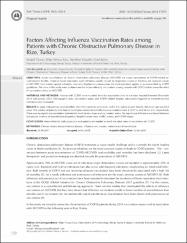| dc.contributor.author | Özyurt, Songül | |
| dc.contributor.author | Kara, Bilge Yılmaz | |
| dc.contributor.author | Özçelik, Neslihan | |
| dc.contributor.author | Şahin, Ünal | |
| dc.date.accessioned | 2020-12-19T20:42:44Z | |
| dc.date.available | 2020-12-19T20:42:44Z | |
| dc.date.issued | 2018 | |
| dc.identifier.citation | Özyurt, S., Kara. B.Y., Özçelik, N., Şahin, Ü. (2018). Factors affecting influenza vaccination rates among patients with chronic obstructive pulmonary disease in Rize, Turkey. Turkish Thoracic Journal, 19(3), 122-126. | |
| dc.identifier.issn | 2149-2530 | |
| dc.identifier.uri | https://doi.org/10.5152/TurkThoracJ.2018.17075 | |
| dc.identifier.uri | https://app.trdizin.gov.tr/makale/TXpBNE5EazRPQT09 | |
| dc.identifier.uri | https://hdl.handle.net/11436/5770 | |
| dc.description.abstract | OBJECTIVES: Acute exacerbations of chronic obstructive pulmonary disease (AECOPD) are major components of COPD-related socioeconomic burden. Upper or lower respiratory tract infections, usually caused by respiratory viruses or bacteria, are common causes of AECOPD. Vaccination aganist influenza virus and Streptoccus pneumoniae, the most prevalent agents, is recommended by COPD guidelines. The aims of this study were to determine the factors affecting vaccination among patients with COPD and to assess the effect of vaccination status on AECOPD. MATERIALS AND METHODS: Patients with COPD were recruited from the outpatient clinic of a tertiary hospital between December 2014 and January 2015. Demographic data, vaccination status, and COPD-related hospital admissions triggered by tracheobronchial infections were evaluated. RESULTS: In total, 108 patients were enrolled; 102 (94%) subjects were male, and 6 (6%) subjects were female; the mean age was 65.6 years. The number of patients who had received pneumococcal and influenza vaccinations were 8 (0.07%) and 36 (33.3%), respectively. There was no significant correlation between the level of education and vaccination status. No significant difference was found between two groups in terms of exacerbation frequency, hospitalization rates, mMRC scores, and COPD stages. CONCLUSION: More efforts by both physicians and patients are needed to reach the ideal rates of vaccination for COPD. | en_US |
| dc.language.iso | eng | en_US |
| dc.publisher | AVES | |
| dc.rights | info:eu-repo/semantics/openAccess | en_US |
| dc.subject | Biyoteknoloji ve Uygulamalı Mikrobiyoloji | en_US |
| dc.subject | Kronik Obstrüktif Akciğer Hastalığı | en_US |
| dc.subject | Grip Aşısı | en_US |
| dc.subject | Pnömokok Aşısı | en_US |
| dc.title | Factors affecting influenza vaccination rates among patients with chronic obstructive pulmonary disease in Rize, Turkey | en_US |
| dc.type | article | en_US |
| dc.contributor.department | RTEÜ, Tıp Fakültesi, Dahili Tıp Bilimleri Bölümü | en_US |
| dc.identifier.doi | 10.5152/TurkThoracJ.2018.17075 | |
| dc.identifier.volume | 19 | en_US |
| dc.identifier.issue | 3 | en_US |
| dc.identifier.startpage | 122 | en_US |
| dc.identifier.endpage | 126 | en_US |
| dc.ri.edit | oa | en_US |
| dc.relation.journal | Turkish Thoracic Journal | en_US |
| dc.relation.publicationcategory | Makale - Uluslararası Hakemli Dergi - Kurum Öğretim Elemanı | en_US |


















